Exercises (2276)
Pulling an object towards you while standing ► row battle rope
Power
Individual work
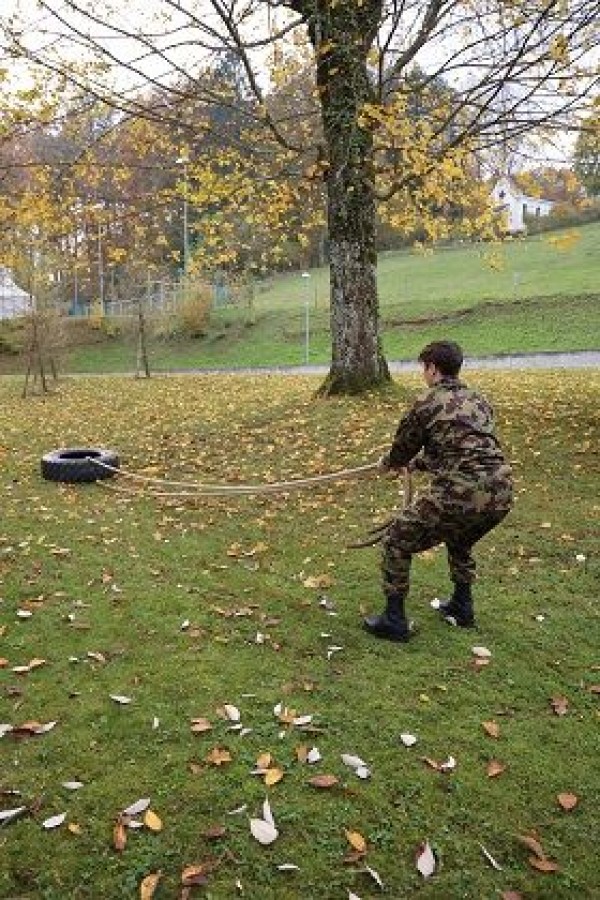
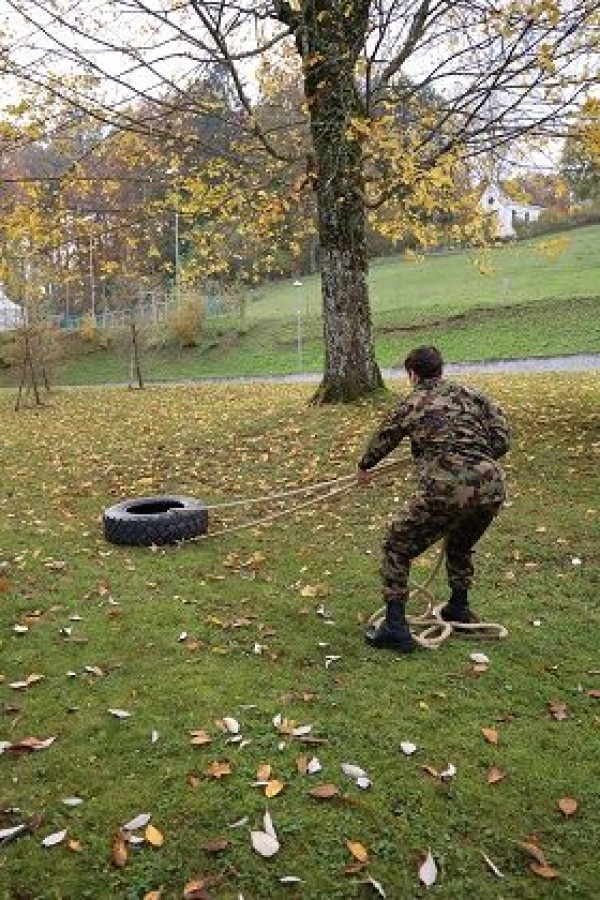

Stand shoulder-width apart at the ends of the rope (facing the tyre), bend your knees slightly, grasp both ends of the rope with your hands and pull the tyre attached to the rope towards you. Once you have pulled the tyre up to your feet, sprint to the other side until the rope is taut again to restart the exercise.
Attention:
Keep your back straight.
Lighten:
Less weight/load.
Harden:
More weight/greater load.
1 rope/rope
1 tyre (DURO)
1 tyre (PUCH) ► Make the exercise easier
1 tyre (10DM) ► Make the exercise more difficult (additional weight)
Gehen ► suitcase carry
Power
Individual work
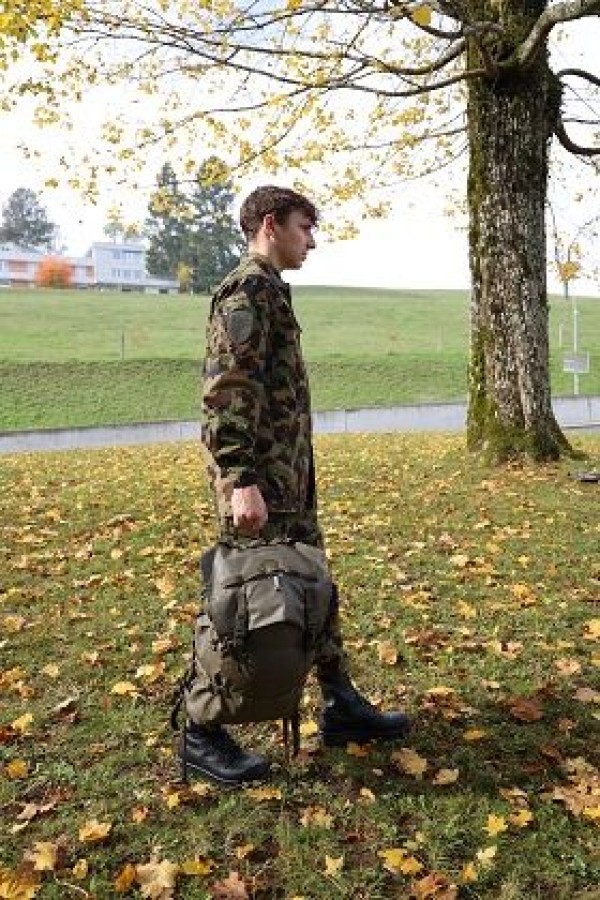
Grab an object (e.g. sandbag or rucksack) with each hand, keep your arms hanging next to your body and transport objects over a certain distance.
Attention:
Keep your back straight and your pelvis stable with every step, keep your shoulders fixed (press towards your hips).
Lighten:
Less weight/load.
Harden:
More weight/greater load.
2 combat backpacks/sandbags/dumbbells (medium weight)
2 combat backpacks/sandbags/dumbbells (light) ► Make the exercise easier
2 combat backpacks/sandbags/dumbbells (heavy) ► Make the exercise more difficult
Gehen ► suitcase carry
Power
Individual work

Take an object in one hand (e.g. military equipment or a combat rucksack), let your arms hang at the side of your body and carry the object over a certain distance.
Attention:
Keep your back straight, your pelvis stable with every step and your shoulders fixed (lower towards your hips).
Variant:
Hold an object in both hands.
Lighten:
Equipment approx. 5kg
Harden:
Heavier equipment (add 3 litres of water to the backpack)
Material per participant: Tenue CNK 420, 2 x material of approx. 5kg/10kg/15kg
Additional material: 2 fanjons, 2 PET bottles (1.5l)
Walking on an elevation
Power
Individual work
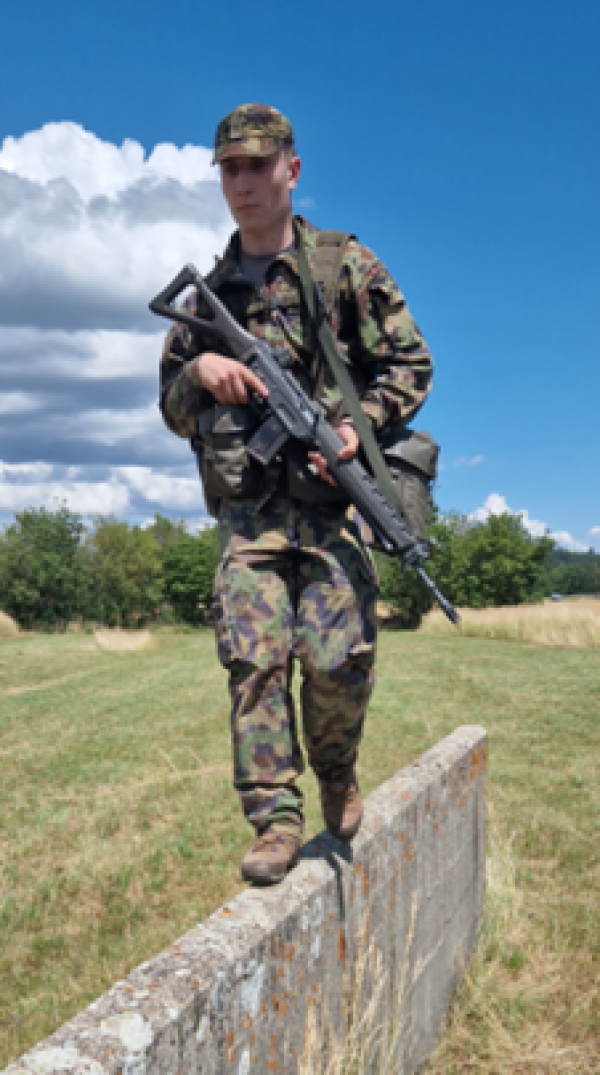
In the CNG 428 tenue, step onto a raised area (e.g. wall); start alternately with the left or right leg (support from a team mate is possible). Run back and forth without stepping off/losing your balance.
Lighten:
Without equipment;
Wider wall.
Harden:
With combat backpack;
Narrower wall.
Material per participant: Tenue CNG 428
Additional material: 1 wall/ruins (station 6 of the outdoor obstacle course)
Buttock rocker ► buttbounce
Coordination exercises
Individual work
Fasten the slackline over a long distance (12-15m) at a height of approx. 1m. Sit in an upside-down position so that your eyes and shoulders are aligned with the end point. From this position, rock downwards and upwards, with the momentum coming from the arms. You can touch the ground with your feet, but you should not actively push off, as the energy should come from the slackline.
Lighten the load:
Help a partner by holding their hand; a helper pushes the slackline down slightly while bobbing.
1 Slackline
Equal numbers: 2 against 2
Forms of play / exercises
Group work
Groups of 4 ► 2 vs. 2
Exercise description:
Players A and B pass a ball/disc to each other in a given space. Players C and D try to gain possession of the ball/disc themselves by intercepting the ball/disc in order to pass the ball/disc to each other. Which team has achieved more passes within a certain time? It is possible to change both partners and opponents regularly (more time required).
Variant:
Which team is the first to complete 10 passes in a row (= 1 point)?
Participant:
1 bat/stick ►intercross/lacrosse, smolball, floorball
Pitch:
1 ball/throwing disc ►basketball, Frisbee Ultimate, FooBaSKILL, futsal/football, handball, intercross/lacrosse, smolball, tchoukball, floorball
4 marking cones/caps (optional) ►pitch boundary
Straddle jump
Floor and apparatus gymnastics






Frontal run-up onto the mini trampoline (from the long bench), one-legged horizontal jump from the run to the two-legged jump on the trampoline vertically into the air.
Grab jump:
Launch with arm pull forwards upwards, legs stretched out as horizontally as possible forwards after the push-off and touch the feet with the hands (if mobility allows). Extend the body again and come to a safe stance.
The participants practise the form of movement independently using series pictures or based on the demonstration of the exercise by the sports leader. The instructor (or a partner) gives feedback, provides support and checks that the exercise is being performed correctly.
1 mini-trampoline
1 long bench (possibly to mark out the run-up)
2 soft mats (large)
5 soft mats (small)
1 row
Straddle jump / squat jump
Floor and apparatus gymnastics








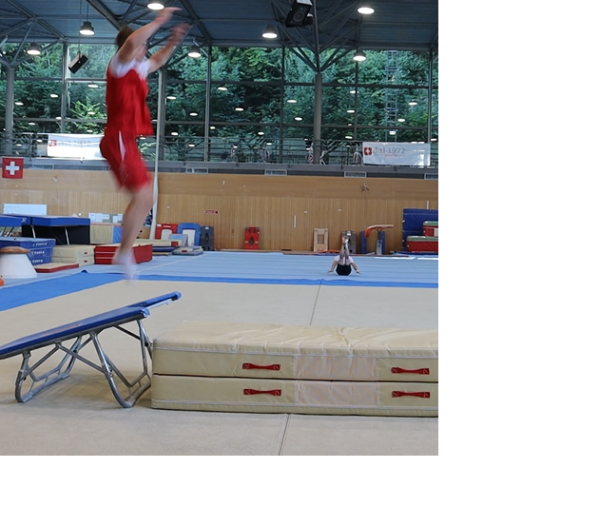



Frontal run-up onto the mini trampoline (from the long bench), one-legged horizontal jump from the run to the two-legged jump on the trampoline vertically into the air.
Grace jump:
Jump off with arm pull forwards, stretch your legs as horizontally as possible forwards after the push-off and touch your feet with your hands (if your mobility allows it). Extend your body again and come to a safe standing position.
Squat jump:
Jump off with your arms pulled forwards, squat your legs (pull your knees towards your chest) and grasp your knees with your hands. Release the squat position and extend the legs to a safe standing position.
The participants practise the movement form independently using series pictures or based on the demonstration of the exercise by the sports instructor. The instructor (or a partner) gives feedback, provides support and checks that the exercise is being performed correctly.
1 mini-trampoline
1 long bench (possibly to mark out the run-up)
2 soft mats (large)
5 soft mats (small)
2 row pictures
Basic position
Coordination exercises
Individual work
Before attempting the first steps, you should be able to stand on the slackline on just one leg for 5-10 seconds. This has the advantage that you can balance with the second leg. Both the left and right leg must be trained.
Pay attention to the following points:
- Looking forwards;
- Arms above shoulder height;
- Feet straight on the slackline;
- Knees slightly bent;
- Hips upright.
Easing:
Perform the exercise close to the attachment; stretch the slackline taut over a short distance (3-5m); sit a partner in the middle of the slackline to dampen the initial shaking; help a partner by holding their hand (always go with the balancing movement and only stabilise if the slackliner is about to fall).
Hardening:
Cross your arms (in front of your stomach, behind your back or over your head)
1 Slackline
Basic position (boxing position)
Light-Contact
Individual work
The participants practise adopting the basic stance:
The boxing stance is the starting and finishing position for all attack and defence techniques. From a shoulder-width stance, one foot is moved slightly forwards and the knees are bent slightly. The foot that is on the opposite side to the stronger hand is moved forwards (e.g. right-handers have the left leg in front). As an exercise, the participants can stand on a line to place one foot forwards from there. The correct distance between the feet is achieved when the heel of the front foot is just in front of the line (the back foot remains in place - toe on the line). At the same time as stepping forwards, the hanging arms are bent, the hands are clenched into fists and raised to head height. The strong hand (on the side of the back leg) is practically on the cheek, the weaker hand (on the side of the front leg) is held slightly in front of the head at approximately eye level. The weaker side corresponds to the lead hand (jab) and the stronger to the punching hand (straight).
Variant:
To assume the basic stance, you can also simply take two steps forwards from a shoulder-width stance and then stop and assume the basic stance. It is only important that the first step is taken on the side where the stronger hand is located.
Exercise:
From the shoulder-width stance with hanging arms, assume the basic position several times. Small shifts are incorporated in between.
No material required
Group Sumo
Fighting and roughhousing games
Group work
6-10 participants
In group sumo, everyone fights against everyone else. The participants try to stay on the field of mats as long as possible (the field can also be defined with marking cones/caps without mats). Anyone whose body part protrudes over the edge of the mat/field must leave the fighting area. The participant who is the last to remain on the mat area/(grass) field wins, whereby only pulling and pushing the opponent is permitted.
x soft mats (small) ► indoor version
4 marking cones/caps ► indoor and outdoor versions
Cockfighting
Fighting and roughhousing games
Partner work

Two participants line up in a defined area (e.g. the centre circle of the basketball court or an area marked with cones). Both participants stand on one leg (one-legged stance) and have their arms crossed in front of their chest. The participants try to unbalance their opponent by jostling or dodging. The first person to put down their raised leg, fall over or leave the playing field loses. Change legs after each round.
4 marking cones (optional) ►Playing field marking
Post setup:
Define a square-shaped field using cones.
Cockfighting
Fighting and roughhousing games
Group work
The participants stand on one leg (one-legged stance) and have their arms crossed in front of their chest (the leg may be changed from time to time; if necessary, this is determined by the sports director). They try to unbalance their opponents by jostling or dodging them. Whoever touches the ground with both legs or falls over is eliminated. Which participant still hops on one leg at the end?
An additional exercise (e.g. wall sits, press-ups, forearm support) can be determined for the fallen "cocks".
4 marking cones (optional) ►Field markings
Half turn
Coordination exercises
Individual work
In the starting position, the front foot is turned inwards and the back foot is straight on the band. Your body weight is on the front foot. Now turn the back foot 180 degrees and simultaneously change your gaze in a quick movement (similar to a pirouette).
Lighten up:
Help a partner by holding their hand (always go with the balancing movement and only stabilise if the slackliner is about to fall).
1 Slackline
Cross your hand over your bent leg while standing
Power
Individual work


Bend your legs in a standing position, upper body tilted forwards, bend one leg alternately and touch the tip of each foot with your hand crosswise.
Attention:
Knees always remain behind the tips of the feet and point forwards.
Lighten:
Lower your upper body less (touch your knees instead of the top of your feet).
Harden:
Add weight to your arms and/or legs.
2-4 weight cuffs/2 weight balls to make the exercise more difficult (additional weight)
Bring your hand crosswise to your knee in push-up position ► knee touch / knee tap push up position
Power
Individual work


Push-up position (high support, face/gaze downwards), buttocks slightly raised, touch the opposite foot or knee with one hand, without lifting the legs. Switch sides after each exercise.
Attention:
Keep your upper body stable (tense your stomach).
Lighten:
Just hold the basic position (push-up position).
Harden:
Additional weight on the arms; unstable support.
2 weight cuffs ► making the exercise more difficult (additional weight)
2 balance cushions/1 balance board ► making the exercise more difficult (unstable base)
Bring your hand crosswise to your shoulder in push-up position ► Shoulder tap push up position
Power
Individual work



Push-up position (high support, face/look down), bring one hand crosswise to the shoulder. Switch sides after each exercise.
Attention:
Head, torso, hips and knees practically form a line (do not stretch your buttocks upwards or let them sag, tense your stomach).
Lighten:
Just hold the basic position (push-up position); place your knees on the floor.
Harden:
Additional weight (on your back or arms); unstable base.
2 weight cuffs/1 weight vest/weight disc/sandbag ► Make the exercise more difficult (additional weight)
1-2 balance cushions/1 balance board ► Make the exercise more difficult (unstable surface)
Bring hand and foot together crosswise while standing
Power
Individual work


Stand upright on the balls of your feet, shoulder-width apart, alternately lift one foot while hopping and touch it with your hand crosswise in front of your body at hip level.
Attention:
Do not put your heels down completely (keep jumping on your toes).
Lighten:
Lift your foot less (possibly without touching it with your hand).
Harden:
Lift your foot higher; additional weight (on your legs).
2 weight cuffs/1 weight waistcoat ► Make the exercise more difficult (additional weight)
Bring hand and foot together crosswise in four-footed stance backwards alternating ► toe tap / toe touch
Power
Individual work
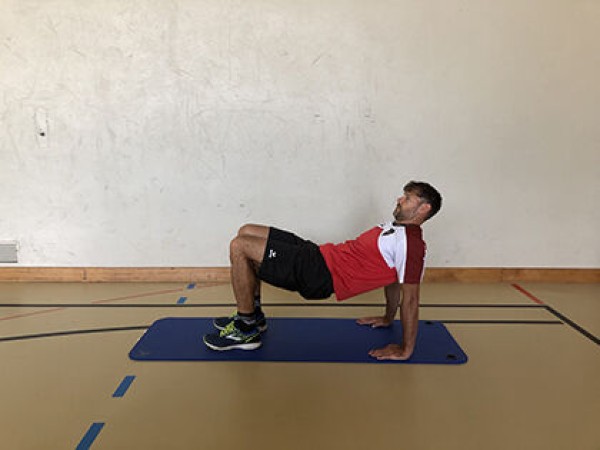

Inverted four-foot stance (chest pointing upwards, body supported on hands and feet, fingertips pointing forwards). Raise one arm and one leg crosswise and bring the hand and foot together. Switch sides after each exercise.
Lighten:
Just hold the position or raise your arm and leg only slightly (without bringing your hand and foot together).
Harden:
Additional weight.
2-4 weight cuffs/1 weight waistcoat ► Make the exercise more difficult (additional weight)
Bring hand and foot together crosswise in push-up position ► mountain climber toe touch / toe tap (climber tap)
Power
Individual work



Push-up position (high support, face/gaze downwards), bring one hand and one foot together crosswise, keeping the arm stretched and the leg bent (knee approximately at chest height). Switch sides after each exercise.
Attention:
Keep your upper body as stable as possible (tense your stomach).
Lighten:
Just hold the basic position (push-up position).
Harden:
Additional weight on arms and legs; unstable base.
Variant:
Cross your elbows to your knees.
2-4 weight cuffs ► Make the exercise more difficult (additional weight)
1-2 balance cushions ► Make the exercise more difficult (unstable base)
Bring hand and knee together in lateral forearm support (left) ► knee raise lateral pillar bridge / side bridge
Power
Individual work


Side support on the (right) forearm (possibly on a wall for the correct straight position), bring the upper hand (or elbow) and upper knee together (approximately at the level of the navel) and back to the starting position.
Attention:
Head, torso, hips and knees practically form a line (pelvis does not tilt backwards or forwards), keep the shoulder above the elbow.
Lighten:
Place the lower knee on the floor; bend the leg less; only hold the position.
Harden:
Additional weight for the arm and/or training leg; unstable base (possible for both the supporting arm and the supporting leg).
2 weight cuffs/1 weight ball/dumbbell ► Make the exercise more difficult (additional weight)
1 ball/1-2 balance cushions/1 balance board ► Make the exercise more difficult (unstable surface)
Bring hand and knee together in lateral forearm support (right) ► knee raise lateral pillar bridge / side bridge
Power
Individual work

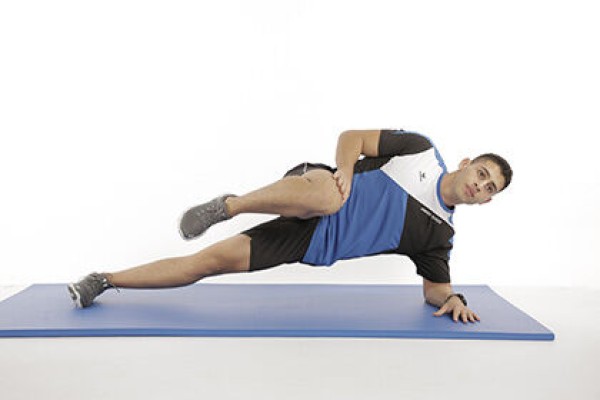
Side support on the (left) forearm (possibly on a wall for the correct straight position), bring the upper hand (or elbow) and upper knee together (approximately at the level of the navel) and back to the starting position.
Attention:
Head, torso, hips and knees practically form a line (pelvis does not tilt backwards or forwards), keep the shoulder above the elbow.
Lighten:
Place the lower knee on the floor; bend the leg less; only hold the position.
Harden:
Additional weight for the arm and/or training leg; unstable base (possible for both the supporting arm and the supporting leg).
2 weight cuffs/1 weight ball/dumbbell ► Make the exercise more difficult (additional weight)
1 ball/1-2 balance cushions/1 balance board ► Make the exercise more difficult (unstable surface)
Move hand to heel in supine position alternating ► heel touch / heel tap
Power
Individual work

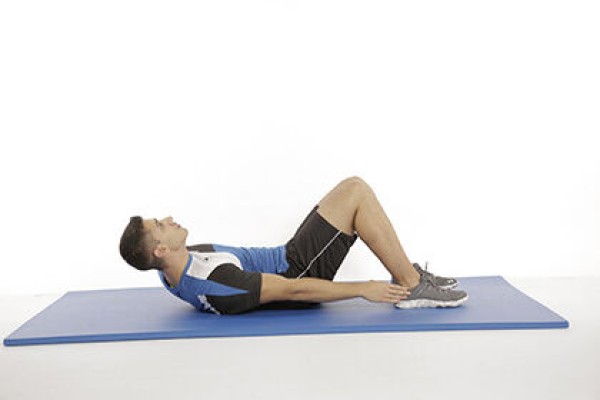
Lie on your back with your legs bent (feet also bent or flat on the floor), arms outstretched and slightly raised next to your body, hands alternately on your left and right heels (tilt your upper body sideways).
Attention:
Do not lower your shoulders completely (constant tension).
Lighten:
Lower your hands forward; only hold the centre position with your upper body raised.
Harden:
Hold additional weight on your arms/in your hands.
2 weight cuffs/weight balls/dumbbells ► Make the exercise more difficult (additional weight)
Bring hand to shoulder crosswise in push-up position alternating ► biceps curl push up position
Power
Individual work


In the push-up position, hold a dumbbell in each hand and alternately move one dumbbell to the opposite shoulder by bending one arm (return to the push-up position in between).
Caution:
Keep the torso stable and don't let it sag (actively tense the torso muscles).
Lighten:
Less weight.
Harden:
More weight; additional weight (on the back).
Variant:
Combine exercise with push-ups (i.e. bend and stretch left arm, push-up, bend and stretch right arm, push-up, etc.).
2 dumbbells
1 weight vest/weight disc/sandbag ► Make the exercise more difficult (additional weight)
Handball
Games / Tournament
Game idea:
Two teams with several outfield players and a goalkeeper each throw the ball into the opponent's goal through skilful attacking. Good defensive behaviour should prevent the opponent from scoring goals.
Scoring:
A goal is scored when the ball crosses the opponent's goal line in its entirety.
Playing field:
Handball field (20mx45m) with goal circle.
Number of participants:
7 against 7 (6 outfield players plus 1 goalkeeper).
Playing rules:
The game is started by a kick-off by one team in the centre of the field. The ball carrier may take a maximum of three steps with the ball in his hands. In order to move, the ball must therefore be bounced or passed to each other. If a player is in possession of the ball, he may catch the ball a maximum of two times. If the ball is picked up after being bounced, it may not be bounced again. The ball may not be held in the hands for longer than 3 seconds and may not touch the body below the knees ("foot rule").
It is forbidden to snatch or knock away the held ball. It is also prohibited to hold the opponent by the body or clothing. Such fouls result in a free throw at the place of the incident. If the foul occurs between the free-throw line and the goal circle, the free throw is taken from the free-throw line. No attacking player may be between the free-throw line and the goal circle when the free-throw is taken. If the foul prevents a clear scoring opportunity, a 7m throw is awarded (direct goal kick from the 7m line; the front foot must not be moved).
The goal circle may not be entered by the field players. However, jumping into the goal circle is permitted, provided the ball is played/thrown before touching the ground. The goalkeeper may move freely within the goal circle and prevent hits with all limbs.
If the ball leaves the pitch over the touchlines, the ball is returned into play by the opposing team with a throw-in (normal pass with the front foot on the line). If the ball crosses the baseline, a throw-in is taken by the goalkeeper (exception: a defender touches the ball before it leaves the pitch over the baseline; in this case, a throw-in is taken in the respective corner of the pitch by an attacker).
After a goal, the right to attack changes. The kick-off is taken in the centre of the field by the team that scored the goal.